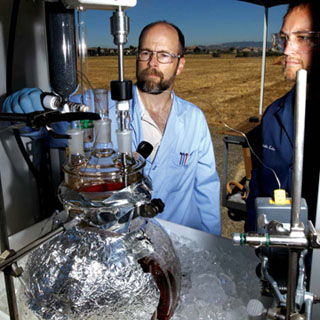
TTim Shepodd (8223) liked the moniker and agreed to call it the chili cookoff. But there was no chili involved, and the only cooking had to do with the kind of chemicals not usually found on Sandia grounds. The chili cookoff a controlled airborne release of chemicals in support of a project funded by the United States Northern Command (USNORTHCOM) took place June 29-July 2 on Sandia/California grounds (outside MANTL, the Micro and Nano Technologies Laboratory).
USNORTHCOM was established in 2002 to provide command and control of DoD homeland defense efforts and to coordinate defense support of civil authorities.
STRANGE BREW LeRoy Whinnery, left, and Greg OBryan mix up a batch of chemicals used to make crystal methamphetamine during field tests to determine the ability of various sensors including airborne sensors to detect an effluent signature or mix of chemicals that might suggest illegal drug manufacturing. The project was funded by US Northern Command (USNORTHCOM). (Photo by Randy Wong)
The agency routinely works with non-US law enforcement authorities.
For the experiment, Tim, a team of Sandia chemists, and other staff members essentially created a crystal methamphetamine laboratory to test a number of sensors that could be used by international law enforcement agencies. USNORTHCOM officials stress that, due to domestic privacy laws, such surveillance activities are only conducted internationally.
The common industrial chemicals used in the experiment, Tim says, are those most often used for illicit drug manufacturing and are those that law enforcement typically finds in illegal drug labs. Sandia chemists LeRoy Whinnery and Greg O’Bryan (both 8223) prepared three “cooks” of chemicals made up of common chemical “recipes.”
The objective, Tim says, was to successfully detect an effluent signature or mix of chemicals that might suggest illegal drug manufacturing. Eight sensors, including one used aboard an airborne platform, were used, with various wavelengths and sensitivities in play. The sensors were those typically used in government and industrial applications, including common pollution detectors, natural gas leak detectors, and sensors used by the Army during wartime.
Each piece of detection equipment used in the experiment was successful at detecting the chemicals, says Tim. Some of the sensors detected at a near-real time six-second refresh rate, while others — such as the airborne sensor — required post-processing.
The next step in the project, says Tim, will be to develop “ground truth” calibrations that will allow USNORTHCOM to better understand whether detection systems can be a long-term solution for shutting down illicit drug manufacturing outside the US. “Ground truth” data is collected on location, which is important since it relates image data to genuine features and materials on the ground.
“It’s one thing to detect a cloud,” as Tim puts it, “but quite another to detect 26 parts-per-million of species x.” The collection of ground truth data enables calibration of remote-sensing data and aids in the interpretation and analysis of what is being sensed.
Once USNORTHCOM determines the ability of the detection system to be successfully deployed in a realistic situation, more Sandia experiments will likely occur. “We would then look at different chemical concentrations, different ingredients, and different recipes,” says Tim.
“This was an important first step,” he says. “It was definitely a success.”